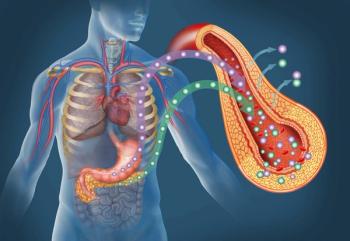
Immuno-Polychemotherapy Elicits Favorable Response in Primary Extra-Nodal Non-Hodgkin Lymphomas of Head and Neck
Poorer prognosis was linked to factors such as reduced hemoglobin levels and advanced stage at diagnosis.
Via a retrospective observational study, investigators analyzed patients with primary extra-nodal non-Hodgkin lymphomas (PE-NHL) of the head and neck and found positive responses to treatment with immune-polychemotherapy, according to results published in Oral Surgery, Oral Medicine, Oral Pathology, and Oral Radiology.1
Specific prognostic factors were also identified that are associated with a poorer prognosis. These include low levels of hemoglobin, elevated Eastern Cooperative Oncology Group (ECOG) performance status, clinical stage at diagnosis, and age at diagnosis, among others.1
NHL commonly originates in the lymph nodes, but up to 35% of cases can present with extra-nodal disease when diagnosed. Furthermore, lymphomas that occur in the oral/paraoral region make up less than 10% of head and neck lymphomas yet represent the most frequent malignant tumors in that region. The low incidence yet malignant nature of its presence in the head and neck region has necessitated more precise diagnostic mechanisms of these tumors.1
Despite enhanced research efforts, few studies have investigated prognostic and survival factors for extra-nodal lymphomas in the head and neck. With recent advancements in treatment such as polychemotherapy and monoclonal antibodies in mind, the investigators aimed to evaluate prognostic factors and detail the clinical and biological characteristics of this pathology.1
In total, 145 patients were enrolled. Key characteristics included the population comprising mostly of men (n = 74; 51%), with a mean age at presentation of 67.3 ± 16.6 years, with a median of 69.7 years. Additionally, 69.3% of patients in the trial presented with localized stages of lymphoma (I-II), whereas 30.7% had indications of advanced stages (III-IV).1
Most cases (54.5%) were diffuse large B-cell lymphoma, with the next most common subtypes being follicular lymphoma (FL) and mantle cell lymphoma (MCL), which accounted for 13.1% and 11.7% of patients, respectively. Across all the NHL cases, 91.8% exhibited a B-cell phenotype, with only 7.6% originating from T/NK cells.1
Immunochemotherapy was the primary treatment approach utilized among 78% of patients, typically consisting of rituximab, cyclophosphamide, adriamycin, vincristine, and prednisone (R-CHOP) for B-cell lymphomas and CHOP for T/NK lymphomas. In 18% of cases, immunochemotherapy in combination with radiotherapy was administered, while only 2% of patients received radiotherapy along. After first-line treatments were administered, overall responses (OR) were observed in 77.9% of cases and complete responses (CR) were seen in 66.2% of patients.1
At 3- and 5-year follow-up points, overall survival (OS) rates were 75% and 73%, respectively. Through a multivariate analysis, the investigators discovered that high lactate dehydrogenase (LDH) levels, high ECOG scores, and low hemoglobin levels had a significant impact on rates of survival.1
Another trial of patients with PE-NHLs, conducted by Bagan et al, served as a point of comparison throughout the discussion of this current study. They found a higher incidence of NHLs in males (55.9% compared with 51%), as well as an earlier onset (59.7 mean age compared with 67.3 mean age).1,2
In this study, practically all patients presented good performance status at diagnosis. The usual signs and symptoms that were associated with tumor development were swelling, pain, and dysphagia. Continuing, over two-thirds of the enrolled patients were diagnosed in the early stages of disease with only one-third in advanced stages, percentages that are like those reported by Bagan et al.1,2
Progression-free survival and 5-year survival rates were very positive, with rates of 68% and 73% respectively, demonstrating a sustained response with immune-polychemotherapy. Further, there were no significant differences in survival between patients with low- and high-grade histology’s. The investigators found that these results were significantly better than those observed from other authors analyzing lymphomas of the same location.1
“Within this treatment framework, elevated LDH values, reduced hemoglobin levels, deteriorated performance status, and advanced stage at diagnosis correlate with a poorer prognosis,” the study authors concluded. “Hence, understanding these prognostic factors could facilitate the optimization of follow-up and therapy for this specific subset of non-Hodgkin lymphomas.”1
REFERENCES
1. Castro AB, Orgueira AM, Sampedro FG, et al. Prognostic and survival factors in head and neck extra-nodal non-Hodgkin’s lymphoma. O Surgery, O Med, O Path, O Radio. 2024. doi:10.1016/j.oooo.2024.09.007
2. Bagan JV, Carbonell F, Gómez MJ, et al. Extra-nodal B-cell non-Hodgkin’s lymphomas of the head and neck: A study of 68 cases. Amer J Otolaryn. 2015;36(1):57-62. doi:10.1016/j.amjoto.2014.10.008
Newsletter
Stay informed on drug updates, treatment guidelines, and pharmacy practice trends—subscribe to Pharmacy Times for weekly clinical insights.














































































































































































































